 Abraham Lincoln
If given the truth, the people can be depended upon to meet any national crisis...
Abraham Lincoln
If given the truth, the people can be depended upon to meet any national crisis...
 Guildford news...
for Guildford people, brought to you by Guildford reporters - Guildford's own news service
Guildford news...
for Guildford people, brought to you by Guildford reporters - Guildford's own news service
Clues To Surrey’s First School For Gypsies Deep In The Hurtwood
Published on: 30 Jun, 2020
Updated on: 4 Jul, 2020
By David Rose
Deep in the Surrey Hills within the Hurtwood, between Farley Green, Shere and Ewhurst, was once a school for Gypsy children, it being the first of its kind in Surrey.
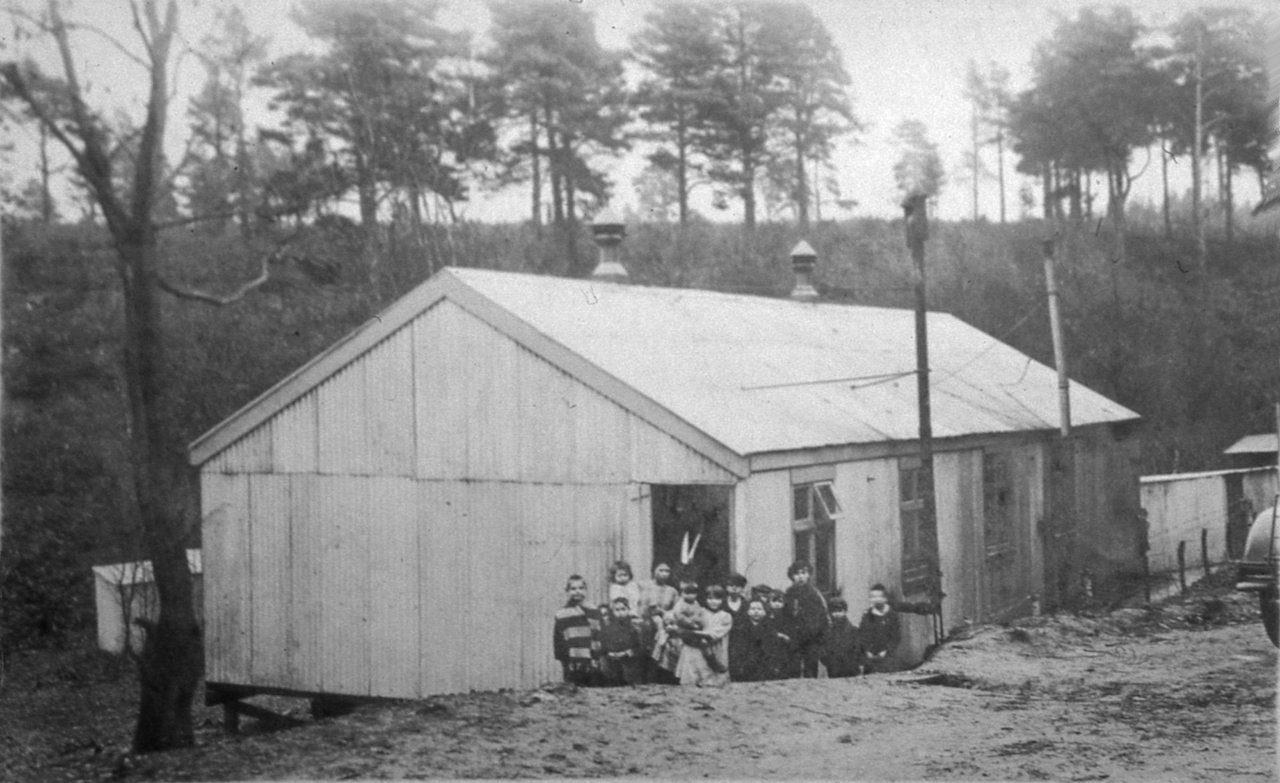
The Gypsy school in the Hurtwood. Picture from Albury History Society’s website. Most pictures can be clicked on to enlarge.
I first came across evidence of the school from an old British Pathé newsreel uploaded to YouTube. The film clip dates to 1926, and while it does not have a soundtrack the opening title states: “School for Gypsy Children. Little folk of the Romany Community of Hurtwood, have their first experience of lessons in woodland school.”
Lasting two minutes and 20 seconds, the film is a fascinating glimpse into the lives of the children as they make their way down a woodland track to the corrugated iron-clad school building and then pictured inside having lessons from their teacher.
There is a further British Pathé newsreel uploaded to You Tube of Gypsies in the Hurtwood, and a remarkable one at that, which we’ll come to later.
The illustrated talk I give with Geoff Burch, A Romany Lifestyle, includes details of Gypsy-travellers who for many years lived relatively undisturbed deep in the Surrey countryside including the Hurtwood.
For years, travelling people had been generally accepted by the ‘settled’ population of counties like Surrey. By the early 1900s their numbers had increased by those forced out of London and its environments by the police, local authorities and the expansion of its boundaries by development.
Surrey’s Gypsies and travellers set up camps along roadside verges, in woodland and on heathland, selling their wares locally, as well as there being plenty of employment on farms harvesting crops such as soft fruit, vegetables and hops.
However, during the early years of the 20th century wealthy landowners increasingly began to try to evict them. In Surrey that included Lord Onslow and Sir Reginald Bray of Shere. There was certainly trouble ahead, by why was a school opened for them?
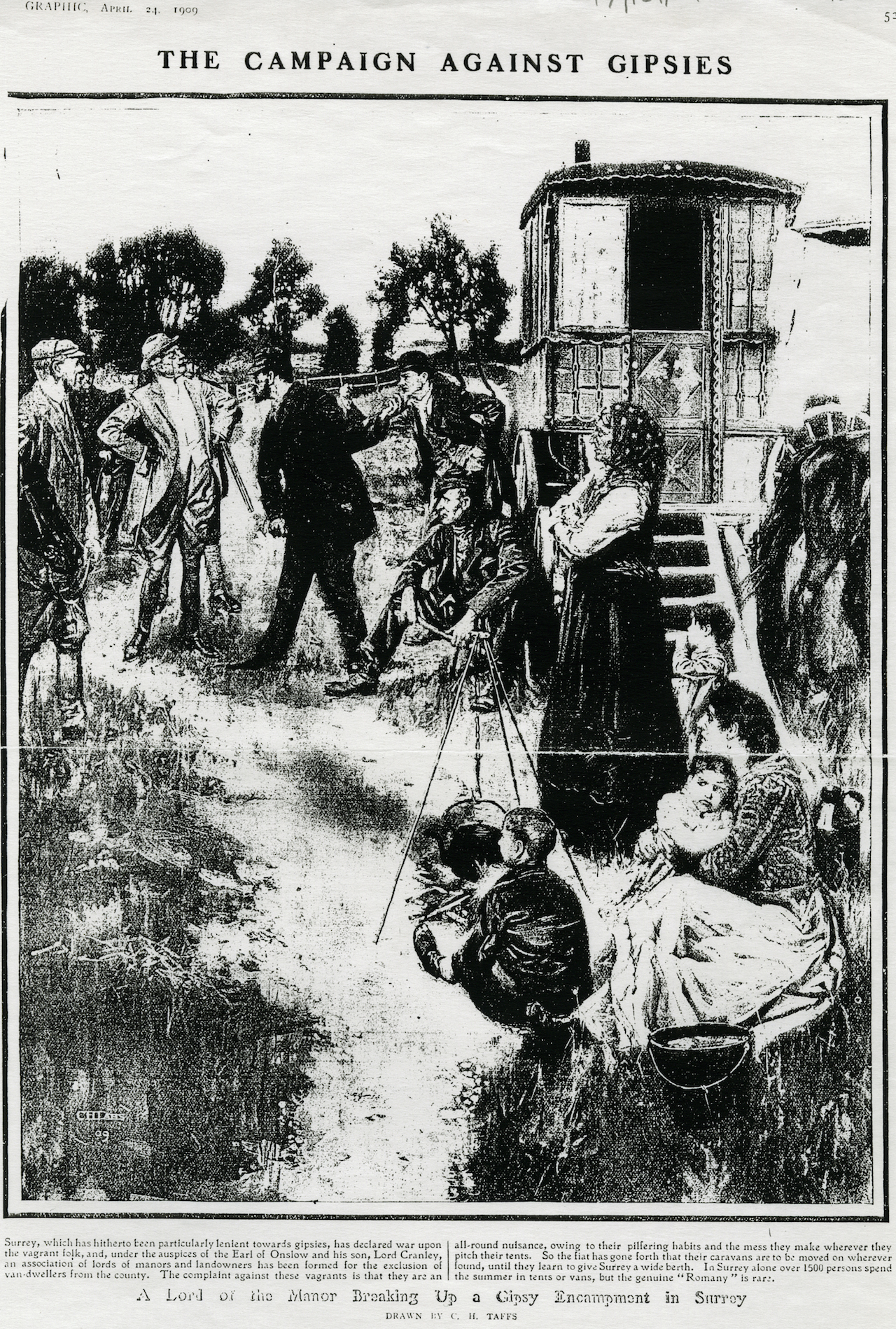
A page from the Graphic magazine in 1909 of a ‘Surrey lord of the manor breaking up a Gypsy encampment’.
With bit of new research into the Hurtwood Gypsies, plus help from Di Stiff at the Surrey History Centre, the story of them and the school can be told.
A detailed report by Paul Bowen, The Schooling of Gypsy children in Surrey 1906-1933, published in 2006, based on Surrey County Council Elementary Education Department minutes held at the Surrey History Centre and correspondence at the National Archives, explains a good deal. He writes: “In the 1920s Hurtwood was a semi-permanent home for a Gypsy colony living in wattle tents who were even ‘thick upon the ground all the winter months’.
“Pressure for the establishment of a school came from a local resident, Mrs P. Donkin, who in a letter to the Board of Education commented that the children of Hurtwood are ‘good material but slowly and surely are running to waste. A few years hence they will be for the most part a danger to themselves and the community and many must become part of the regular prison population’.”
Paul Bowen also notes: “…. the issue of Gypsy children and compulsory education requirements did emerge as a significant problem in the early years of the 20th century challenging the Board of Education, local authorities as well as individual schools.”
It’s not surprising that attempting to enforce the schooling of Gypsy children was a problem, given their lifestyle of moving from place to place, and living in sometimes remote locations such as the Hurtwood and being some distance from the nearest village schools. Added to this, when Gypsy children did attend schools, parents from the ‘settled’ community often complained to the schools and education authorities about their own children having to mix with them!
Mrs Donkin’s words appeared to have been acknowledged as in November 1925 Surrey Education Committee sanctioned £250 for a portable school building for the Hurtwood Gypsy children.
Paul Bowen quotes from records at the time: “The building provided was a simple, rectangular iron and wood structure providing accommodation for 40 children. It was of a portable, kit-built construction because ‘if and when, for one reason or another, the community served by the school resumes its wanderings, the school will in due course be transported to the next settlement’.”
The school officially opened on January 11, 1926, and although take-up was slow to begin with, within a few months 70 children and even 59 adults attending morning, afternoon and evening classes.
The curriculum focused on arithmetic, reading and writing with time also devoted to history, geography, gymnastics and citizenship. Emphasis was also placed on the children doing basketry, woodwork, metalwork, needlework, rug-making, boot-making, raffia-work and gardening, all relevant to their traditional employment opportunities.
The teacher was Alfred Milner, whose wife also taught at the school. They lived on the site in a caravan (costing £174).
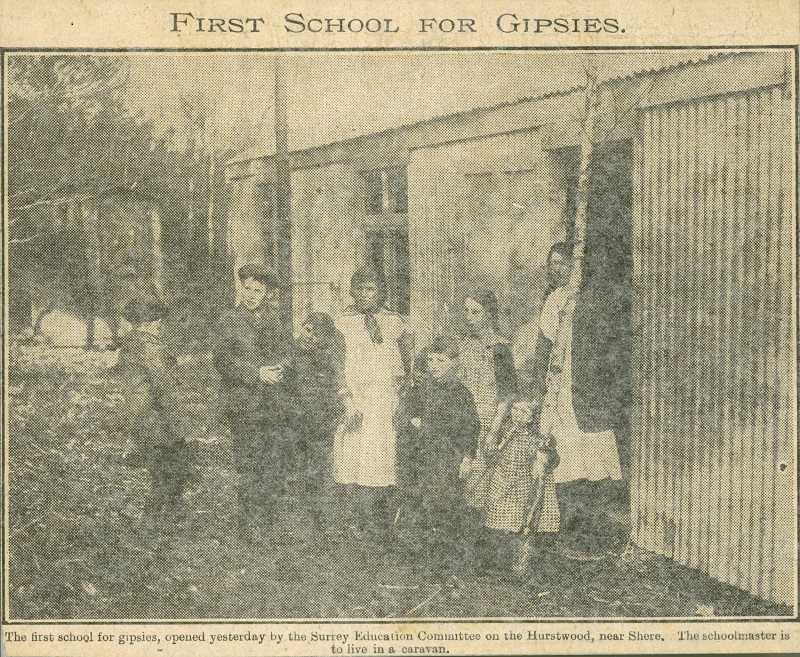
In 1926 the Daily Express reported on the school. Cutting from the Surrey History Centre’s Exploring Surrey’s Past website page on the Hurtwood Gypsy school.
Reports on the progress of the school have been noted by Paul Bowen: “As most of the Gypsy children could not initially read or write, teaching strategies were often linked to pictorial resources. For example, it was noted on a visit to the school in 1928 that ‘the master’s main requirement is a good supply of pictures, whether in books or frames. These are mightily relished by all the children’.
“Apart from academic and vocational aspects of the curriculum, there was also a focus on health education. Children were given one hot bath a week, the school being equipped with two baths, smoking was discouraged and the master and his wife cut their hair.
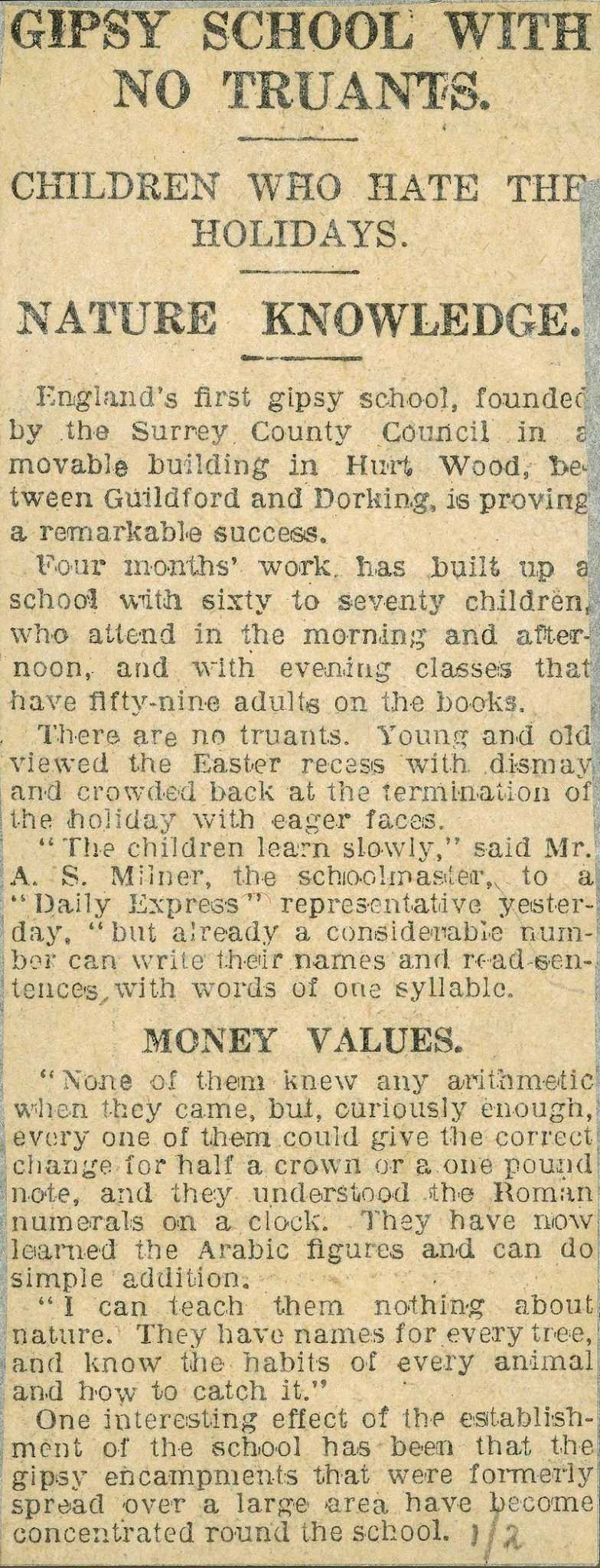
The Daily Express’s story on the Gypsy school in the Hurtwood, also from the Exploring Surrey’s Past website page, as above.
“When the school opened, only four out of 40 children could read or write and developing basic literacy skills was a priority. At playtime the children’s distinctive Gypsy lifestyle became evident. It was noted how they were not used to playtime activities such as football and their fighting instincts often surfaced. On one occasion Mr Milner threw a football to them. A struggle ensued for some time but ‘eventually a boy, his face scratched and his clothes still more torn, came running breathless to the master remarking: ‘There it is Sir, I got it’. At playtime, it was noticeable how many went straight for the trees to climb them.”
Alfred Milner appears to have been a teacher of great resources and understanding of Gypsy culture, as “regular social events were held where Romany song and dance were enjoyed”.
Despite Mr Milner’s enlightened approach, Paul Bowen notes that the school “…can also be interpreted as an assimilationist strategy seeking to prepare Gypsies for integration into mainstream society. A visitor to the school in 1928 was told that every effort is made to train the girls sufficiently that by the age of 16 they may be placed in domestic service and thus weaned from their travelling life.”
And, requests by Mr Milner to take the children to the seaside at Bognor Regis and to acquire relief maps for geography were turned down by the Local Education Authority.
It was indeed a pioneering school, albeit perhaps something of an educational experiment, but did not last. The increasing restrictive practice of local landowners in the area resulted in a decline of the Gypsy community in the Hurtwood, and by November 1932 only 22 pupils were in attendance.
Discussion of closure began to take place, and by February 1933 negotiations were in progress for the remaining Hurtwood Gypsies to move to Walton-on Thames.
There, the East Walton Temporary Council School was scheduled for reopening around Easter 1933, owing to pressure of numbers locally.
The Hurtwood school closed in December 1933. Alfred Milner was appointed the new headteacher at Walton-on-Thames and the Hurtwood school building was moved there at a cost of £300.
The second British Pathé newsreel uploaded to YouTube is, I believe, even more fascinating than the one of the children at the school.
Titled It’s An Old Romany Custom, this time there is sound and it shows the Gypsies packing up and leaving their camp, but before they go they burn down their wattle huts.
Towards the end of the clip, a woman (named as Mrs Sayer) is interviewed, saying she and her family (11 children) are not pleased to be leaving the Hurtwood and that they are going to Walton-on-Thames, but not sure if any work has been found for them.
But, where exactly was the school and the camp? Official records do not seem to give a precise location. Shere and Albury are mentioned as locations, while the Hurtwood and Winterfold Forest do cover a large area.
A clue is provided on the Friends of the Hurtwood website, that states: “…. 1926 Surrey County Council founded the first Gypsy school in England near Wickets Well, due north of Jelley’s Hollow, in what is now part of Winterfold Forest.”
Further information about the Gypsy community in and around the Hurtwood on land owned by Sir Reginald Bray of Shere can be found on Albury History Society’s website.
The Hurtwood Control was set up by Sir Reginald to combat problems associated with his lands.
Notes from a talk given to Albury History Society in 2011, include: “They employed three men to patrol the common lands ‘that are frequented by vagrants…and take steps to prevent and extinguish fires’, but the patrols had to be disbanded during the First World War, and the gypsies became even more troublesome.
“Sir Reginald submitted a formal complaint to The Inspector of Nuisances, Byfleet – and sent an impassioned statement to Parliament, which ends: ‘As regards the evils to the people living in the neighbourhood…it is no exaggeration to say that the Gypsies are regarded as a terror and a nuisance – and that they deprive the inhabitants of some of their enjoyment of this beautiful district’.”
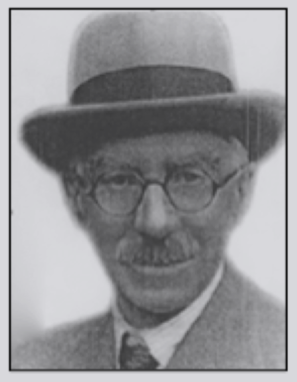
Sir Reginald Bray. Picture from Albury History Society’s website.
However, it appears he tried to accommodate the Gypsies, perhaps to control their numbers.
“But to no avail – Parliament was unmoved. So when Uncle Reggie inherited the estate in 1923 he tried completely different tactics. He established a Gypsy camp, near Wickets Well on the heathland at Winterfold”.
Sir Reginald apparently allowed 100 persons to stay at the camp. He issued a five shilling (25p) licence to each head of a family, provided they behaved themselves and cleared up their rubbish.
“The camp didn’t – it couldn’t – solve all the problems. And at least one local resident complained to the Ministry of Health, because he felt that the Gypsy camp was lowering the tone (and value!) of the area. ‘Winterfold Heath…is a delightful tract of pine-covered heathland, but the formation of the encampment of some hundred persons, including a large proportion of young children renders the landscape a disgusting and disgraceful spectacle.’
“But the Ministry promptly sent an Inspector, who was quite impressed, and didn’t consider the camp to be a hazard to public health.
“An analysis of the water from Wickets Well showed it to be ‘an excellent water for all domestic purposes.’ And in his opinion, the lack of ‘sanitary arrangements’ was unlikely to cause a nuisance’ as the camp is situated in such a large tract of open country.’
“So in 1926, Uncle Reggie was able to write: ‘The Committee I formed are dealing very satisfactorily with the gypsies. The licence system works well. We keep them to two spots. We have a gipsy school run by the council’.
“So he’d succeeded in getting the gypsies more or less under control. But by this time, a far greater menace were motorists – cars and motorcycles – and the environmental catastrophe they caused.”
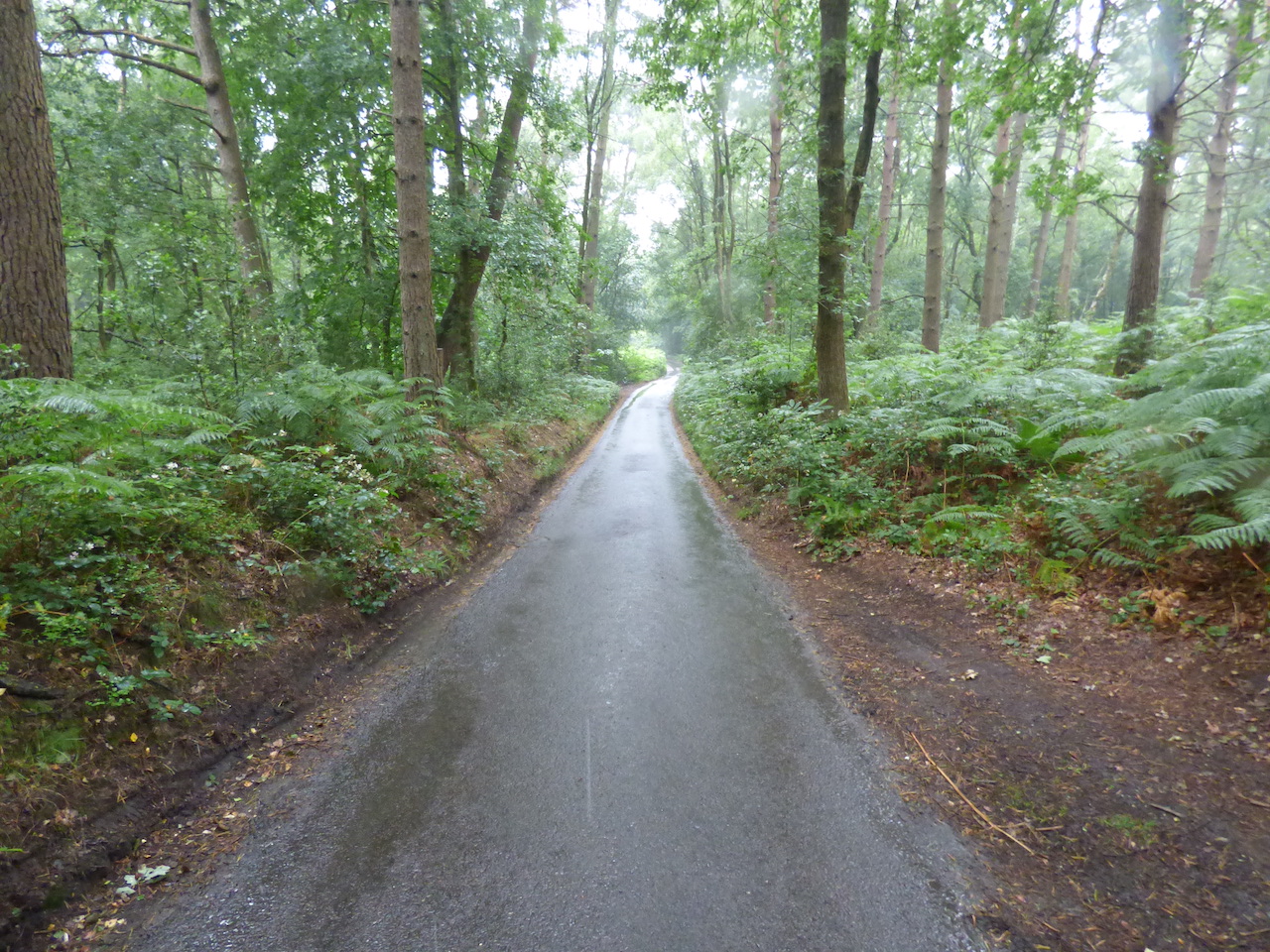
Looking west along the road the crosses the Hurtwood near to where the Gypsy camp and school is likely to have been.
The following memories of the camp can be found by members of Cranleigh Women’s Institute, hand-written in a scrapbook dated 1949, now in Albury History Society’s collection.
Not all of what was written may be strictly correct. Nevertheless, it reads…..
“For many years the Hurtwood was inhabited by a colony of Gypsies who lived in a camp beside Wickets Well.
“Sometime about 1924 a school was started for them near the camp by Lord Eustace Percy and a group of his friends. He was then Minister of Education and resident in Albury.
“The schoolmaster, Mr Milner, at first lived with his family in a caravan near the camp, but his children, being accustom to separate bedrooms and darkness, stayed awake till all hours, and so the family moved to rooms in Shamley Green.
“Beside reading, writing and counting, the children were taught handicraft. The school which was the first of its kind in the country, was an unqualified success so it raised the children enough to enable them to enter elementary schools later on.
“That and the Act of Parliament passed in the early twenties forbidding the lighting of fires on commons and also forbidding caravans and squatters to stay more than two nights on commons struck at the roots of vagabonds who were at that time a running sore for the nation at large.
“Mr Bray in the kindness of his heart allowed a maximum of 100 to stay in what became known as ‘the camp’. He issued a licence to each head of a family, which allowed them to stay contingent on good behaviour, proper disposal of rubbish, etc.
“The Gypsies did still cost the nation a good deal, as though they earned good money – both men and women working in the fields – they paid neither rent, nor rates and taxes.
“They bought no clothes but begged them and when their children had any illness this necessitated their removal to the Poor Law Hospital as the mothers were too ignorant to nurse them, and the tents too damp and insanitary, whereas the villagers who had less money to spend, could and did nurse their own sick.
“The Gypsies spent their money on drink and there were subsequent fights – so much so that the Windmill Inn was forbidden to serve them, as it was the practice of the men to encourage the women to fight each other outside, and this resulted in overcrowded cases in the local courts in the following week.
“It should also be recorded that spadework in civilising the Gypsies was done by Cllr Stone from Cranleigh village – a wonderful man – he and his friends came up on Sunday afternoons for years, leaving their comfortable firesides to come up the hill and stand about in all weathers to teach the children who were so timid and wild that even sweets and oranges would not often tempt them out of their tents.
“This timidity was caused by the fact that they were detested alike by cottagers and landlords – the latter disliked them because they were naturally enough expert poachers, and when they, the Gypsies, became too thick upon the ground and the pheasants too few, the landowners clubbed together and had a drive by the police, who beat down the dwelling shacks and drove the Gypsies out – of course they filtered back again by degrees.
“The only contact with the Gypsies prior to Cllr Stone’s work and the Gypsy school was the police, but they have been so reformed by ‘Christian teaching’ and educated in cleanliness, that they now really are citizens and no longer afraid of the police.
“One of Cllr Stone’s great pieces of work was a tea each summer, up on the forest, to which he persuaded not only the Ewhurst villagers to send cakes, but to come themselves and to bring their children so that Gypsy children and village children ran races together – no mean achievement. It must have needed repeated effort.”
Although the Hurtwood Gypsy school was the first of its kind in Surrey, whether it was the first in England, as some of the quoted reports and memories here suggest, it can’t be confirmed here.
The Surrey History Centre in Woking has a growing collection of written details and images of Gypsies and travellers in the county. It is keen to hear from anyone who has material relating to Surrey’s travelling communities which can help it carry out further research in this area. Send an email to shs@surreycc.gov.uk or phone 01483 518737.
For details see this page on its website.
There are no surviving records of names of pupils who attended the school. However, Di Stiff from the Surrey History Centre said: “The school at the Hurtwood has always been something of an enigma and I have met various people over the years and had enquiries from people who are descended from Gypsy children who attended the school but very few have any concrete information about it.
“The surnames of those who attended I noted were Fagence, Roberts and Hoadley, possibly also Chapman and Bonwick. One person’s great-grandmother attended the Hurtwood school and she said that when the encampment was moved most of the families were moved to six huts at Field Common Lane, Hersham, and this is possibly why they were called Hurtwood Huts.”
Marking Gypsy, Roma and Traveller History Month (GRTHM), (June 2020) Surrey History Centre has published on YouTube a podcast by Alan Wright, the author of Their Day Has Passed: Gypsies in Victorian and Edwardian Surrey, based on a wealth of material held at the centre. In the podcast, Alan talks about Gypsy weddings. There are more deatils on this page on the Exploring Surrey’s Past website.
British Pathé is considered to be the finest newsreel archive in the world and is a treasure trove of 85,000 films unrivalled in their historical and cultural significance. Click here for more details on its website.
And finally… Geoff Burch and I (David Rose) offer our illustrated talk A Romany Lifestyle to groups, societies, and so on. I have been collecting vintage images and stories relating to Surrey’s Gypsy-traveller community for some time, while Geoff’s late mother was born into a Gypsy family who lived in the Old Woking area. He has a wealth of details about that branch of his family and our talk includes much of this and more. For details, email me at davidrosemedia@gmail.com
Responses to Clues To Surrey’s First School For Gypsies Deep In The Hurtwood
Leave a Comment Cancel reply
Please see our comments policy. All comments are moderated and may take time to appear. Full names, or at least initial and surname, must be given.
Click on cartoon for Dragon story: Public Asked for Views on SCC’s Proposal for Reduced Speed Limits



Recent Articles
- Lib Dems Easily Hold Three Council Seats in Surrey By-elections
- UK Students to Launch International Space Mission
- New Skate Park Proposed for Cranleigh
- Retrofit Planned for Guildford Office Building
- Museum Shines a Light on Victorian Send, Ripley and Pyrford
- Guildford Festival Burst with Colour, Culture and Community Spirit
- Conservationists Celebrate Victory As Fast-food Plan At Nature Reserve Is Turned Down
- Incident in High Street – Man Found Unresponsive
- Letter: The Weyside Scheme Is Not Going To Be GBC’s Woking
- Guildford’s First “Bike Bus”


Recent Comments
- Peter Mills on Guildford’s First “Bike Bus”
- Des Flanders on Making History As Pewley School’s Class of ’54 Hold Their Final Reunion
- Margaret Rotherham on Guildford Festival Burst with Colour, Culture and Community Spirit
- Peta Malthouse on Conservationists Celebrate Victory As Fast-food Plan At Nature Reserve Is Turned Down
- James Masterman on Guildford’s First “Bike Bus”
- T Lashbrooke on Guildford’s First “Bike Bus”
Search in Site
Media Gallery
Dragon Interview: Local Artist Leaves Her Mark At One of England’s Most Historic Buildings
January 21, 2023 / No Comment / Read MoreDragon Interview: Lib Dem Planning Chair: ‘Current Policy Doesn’t Work for Local People’
January 19, 2023 / No Comment / Read MoreA3 Tunnel in Guildford ‘Necessary’ for New Homes, Says Guildford’s MP
January 10, 2023 / No Comment / Read More‘Madness’ for London Road Scheme to Go Ahead Against ‘Huge Opposition’, Says SCC Leader
January 6, 2023 / No Comment / Read MoreCouncillor’s Son Starts Campaign for More Consultation on North Street Plan
December 30, 2022 / No Comment / Read MoreCounty Council Climbs Down Over London Road Works – Further ‘Engagement’ Period Announced
December 14, 2022 / No Comment / Read MoreDragon Interview: GBC Reaction to the Government’s Expected Decision to Relax Housing Targets
December 7, 2022 / No Comment / Read MoreHow Can Our Town Centre Businesses Recover? Watch the Shop Front Debate
May 18, 2020 / No Comment / Read More









Hazel Munro
July 1, 2020 at 8:35 am
Hello David, That’s was a great article.
David Rose replies: Thanks Hazel. If Ewhurst History Society has further details or pictures, I’d be very interested in seeing them.
Elinor Goodman
July 1, 2020 at 2:26 pm
I found this piece really interesting.
I was brought up in Bramley and my father owned the common rights at Run Common where the Sayer family lived in the 1950s.
One of Rose Sayer’s descendants still lives there, just near the old railway line, I think.
Fascinating to talk to him about the different branches of how his family have fared.
I also remember old shacks up on Farley Common and Blackheath, which I presume were left over from an old encampment.
It makes me mad when people portray Gypsies as outsiders as they are very much part of the fabric of the countryside.
Sue Hackman
July 1, 2020 at 5:43 pm
Brilliant article. Our predecessors were more open-hearted and more progressive than we imagine.
There is today a dangerous prejudice and a whiff of fear when travellers pass through.
Sadly, travelling children are the lowest-performing in Surrey results.
Maybe the increased use of online learning during the coronavirus will come into its own now.
Sally Carey
July 6, 2020 at 11:17 pm
I have found this very interesting. It is highly likely that my grandmother in law attended this school. Thank you.
Sheila Sewell (nee Fagence)
February 12, 2021 at 1:47 am
I welcomed this article and the information it held on gypsy life.
I am a descendant of Philip Roberts, Phoebe Hoadley Roberts, and the Bonwicks etc. I have recently discovered documents showing they lived on Hurtwood. Its brought my late father and his family alive again and that’s so comforting.
Thank you.
Sherry Bryers
June 28, 2021 at 12:14 pm
A very interesting piece.
My paternal grandfather was a gypsy on Hurtwood. Not sure if he went to the school because he was illiterate.
My father always told the story of an aunt Liza who lived on the common in a crashed First or Second World War glider.
I would love to learn more about the families there.
My father grew up in Peaslake, so his direct family wasn’t shipped off to Hersham.
My family name was Ray and Smith
We have some Chapmans within the family tree.
Vicky Geeves
August 21, 2021 at 10:16 am
What a wonderful article.
I believe my grandmother Elizabeth Sayers, married to Henry, is shown in the video. She went onto to have 13 children, one of which was my dad Maurice.
The little girl with the cat must be my Aunt Violet. Just awful for them, the children, watching their homes burnt to the ground. I think they went on to live on Farley Green heath and not Walton on Thames.